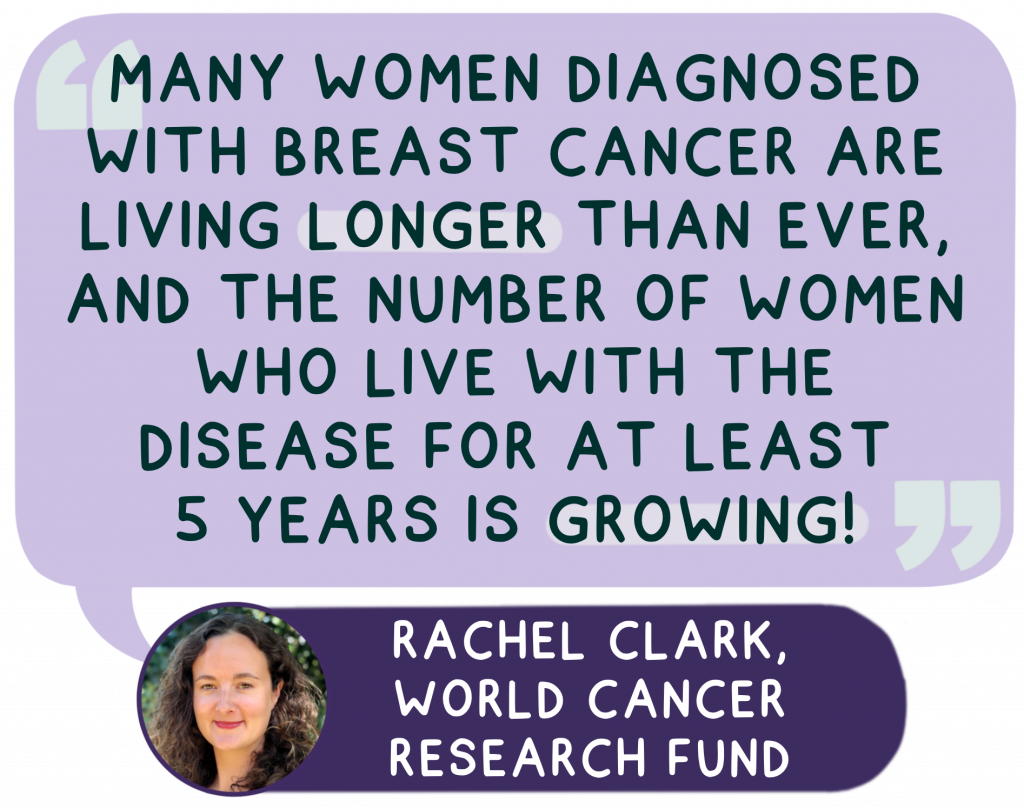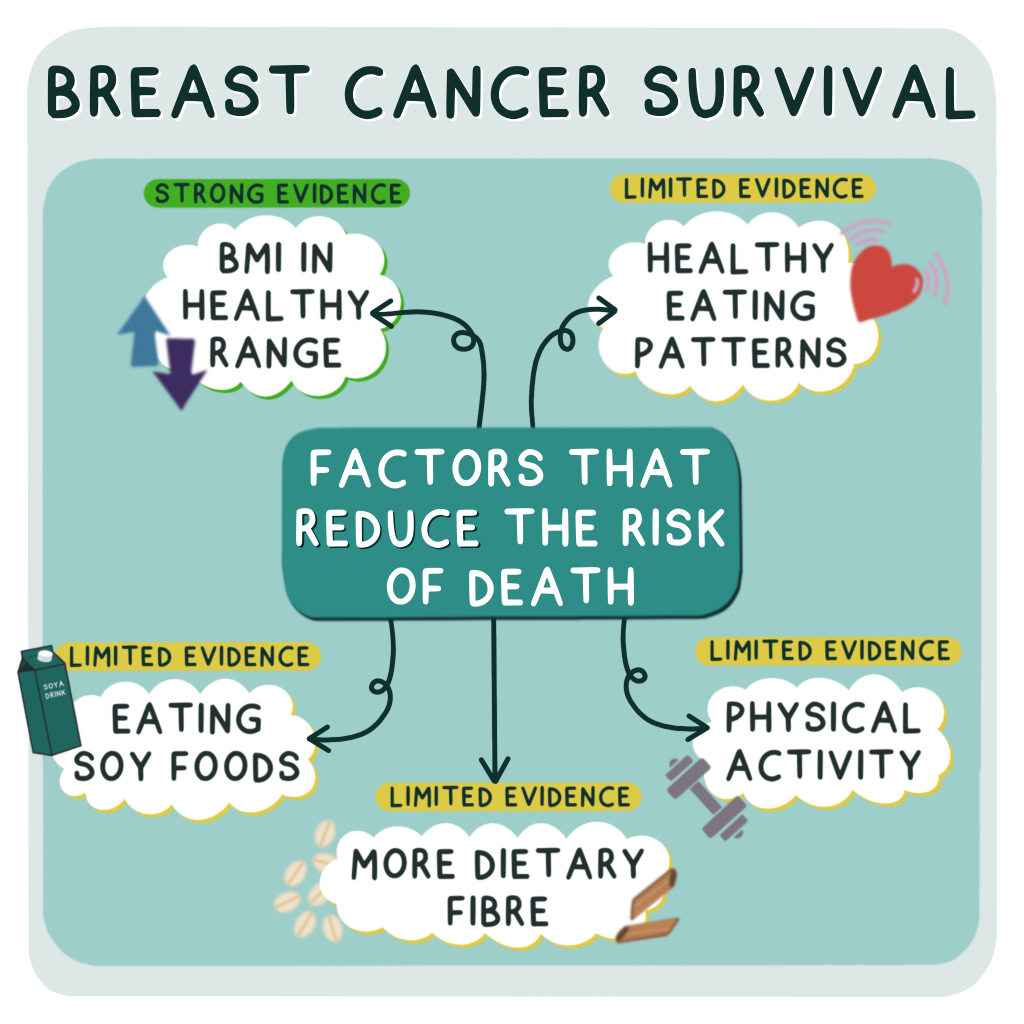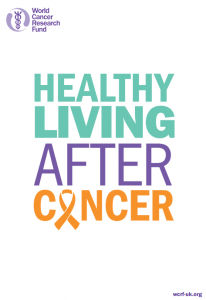
By Rachel Clark , Health Promotion Consultant, World Cancer Research Fund (WCRF)
Rachel is a public health nutritionist who specialises in health promotion, education and engagement. She works with health professionals to increase awareness of the lifestyle-related risk factors for cancer and to support patients and clients to make healthy lifestyle choices.

Many women diagnosed with breast cancer are living longer than ever, and the number of women who live with the disease for at least 5 years is growing. This is why it is so important that we understand how lifestyle behaviours impact the future health of women living with and beyond breast cancer.
Alongside the CUP Global team at Imperial College London, we have analysed global research on the links between diet, weight, physical activity and a woman’s risk of death after a diagnosis of breast cancer. Our major review found strong evidence that a higher body weight after a breast cancer diagnosis increases a woman’s risk of death. We also found some limited evidence that doing more physical activity and eating well could lower the risk of death.
Key findings of the review

- Body weight and risk of death after a breast cancer diagnosis
Our review included a number of risk factors related to body weight: body mass index (BMI), waist circumference and waist to hip ratio. For all 3 measures, higher levels are generally linked to greater health risks.
We found few studies that looked at the effect of BMI change or weight change, and those findings were not clear.
We reviewed 226 studies from around the world, comprising more than 456,000 women with breast cancer. Of them, 36,000 died including 21,000 who died from breast cancer.
- We found strong evidence that a higher BMI, waist circumference, and waist-hip ratio after diagnosis increases the risk of death.
- We found some limited evidence that a higher BMI, waist circumference, and waist-hip ratio after diagnosis could increase the risk of breast cancer recurrence.
For every 5-point (kg/m2) increase in BMI, the risk of dying of any cause was estimated to increase by 7%.
The risk of dying from breast cancer was estimated to increase by 10% and the risk of having a second primary breast cancer by 14% both for every 5-point increase in BMI (kg/m2).
2. Diet and risk of death after a breast cancer diagnosis
We reviewed 108 studies from around the world, comprising more than 151,000 women with breast cancer. Of them, 14,900 died including 5,900 who died from breast cancer.
- We found some limited evidence that eating soy could reduce the risk of death. There was a 4% lower all-cause mortality risk for those consuming higher levels of isoflavone from soy foods, the equivalent of 2mg/day.
- We found some limited evidence that eating soy could reduce the risk of breast cancer recurrence.
- We found some limited evidence that eating more dietary fibre could reduce the risk of death. There was a 13% lower risk of all-cause mortality for each 10g/day increase in fibre intake.
- We found some limited evidence that healthy eating patterns could reduce the risk of death.
3. Physical activity and risk of death after a breast cancer diagnosis
We reviewed 23 studies from around the world, comprising more than 39,000 women with breast cancer. Of them, approximately 5000 died including 2,000 who died from breast cancer.
Most studies looked at recreational physical activity, such as aerobics, walking and running, with limited studies on other types of activity.
- We found some limited evidence that women who were more physically active had a reduced risk of death after a breast cancer diagnosis than women who did less physical activity. The most active women had an estimated 44% reduced risk of all-cause mortality and 42% reduced risk of breast cancer mortality.
- We found some limited evidence that physical activity could reduce the risk of breast cancer recurrence.
The studies measured physical activity using metabolic equivalent of task (MET) – the rate at which the body uses energy (oxygen) during physical activity compared with the energy used at rest. One MET is equivalent to 3.5ml oxygen per kg of body weight per minute. 10 MET hours per week equates approximately to 75 minutes of vigorous activity or 150 minutes of moderate activity.
The estimated reduction in risk for every 10-unit MET-h/week increase in physical activity was 15% for all-cause mortality and 14% for breast cancer mortality. This was seen up to approximately 20 MET-h/week; at this level of physical activity there was 47% reduced risk of all-cause mortality and 38% of breast cancer mortality. There was little further reduction in risk with higher levels of physical activity.

Advice for women living with breast cancer
The findings show that women’s health behaviours after a breast cancer diagnosis seem to be important for their future health, especially in relation to maintaining a healthier weight. This suggests that women should be supported by their healthcare team to follow a healthy diet and be physically active. Being a healthy weight also reduces the risk of other chronic diseases such as cardiovascular disease and diabetes.
Women living with and beyond breast cancer should always consult with their healthcare team before making any changes to their diet or physical activity routine.
Useful resources for living well during cancer
World Cancer Research Fund’s Eat Well During Cancer guide
World Cancer Research Fund’s Healthy Livin g After Cancer guide
g After Cancer guide
World Cancer Research Fund’s Living with cancer web section
Breast Cancer Now’s Healthy eating after breast cancer treatment web page
Macmillan’s Lifestyle and well-being after treatment web page
If you would like to keep up to date with the latest research on lifestyle and cancer, our free package for health professionals includes an online cancer prevention course, free resources, and a subscription to our cancer prevention newsletter.
Take home message
More research is needed on the links between lifestyle and breast cancer survival so that we can give specific dietary and physical activity guidance to women* living with breast cancer. However, emerging evidence suggests that maintaining a healthy weight, being physically active and eating a healthy diet could improve quality of life for women living with breast cancer, as well as lower the risk of dying from the disease.
Related MyNutriWeb Content
Diet and Cancer Myths (2022). Blog post exploring myths
Enjoying Food With Cancer (2022) – MyNutriKitchen with Life Kitchen and Adele Hug
Plant-based diet and bowel cancer (2022) – Blog post
Bowel cancer and red meat (2021) – 60 mins webinar and Key Resources
Alcohol and Cancer (2021)- 60 mins webinar and Key Resources
Breast Cancer and Diet (2021)- 60 mins webinar
Eating well after Cancer (2021) – 60 mins webinar and Key Resources
*Please note, the research discussed within this blog is based on findings on women with breast cancer. We have not covered research on men and breast cancer within this blog.







Great blog, thank you! Were there any differences between women who had been diagnosed with different types of breast cancer, or those that had been diagnosed at different stages?
Hi Amy,
Thanks for your question.
The evidence was strongest for the effects of body weight (primarily measured using ‘body mass index’ which gives an indication of the level of overweight of an individual). Generally, outcomes were worse for those of a higher body weight (although those with a very low body weight also had worse outcomes). The research team did not find differences for different subtypes of breast cancer. But there were some differences according to the stage of the cancer for the risk of recurrence specifically. For those with more advanced cancer, the association was in the opposite direction (ie there was a lower risk of recurrence with higher body mass index). But there was not a huge amount of data looking at this. The research team did not find any notable differences for physical activity or dietary risk factors.
I hope that is helpful.
Is there any information in regards to gene? Women who had relatives diagnosed with breast cancer were more at risk of breast cancer compare to other who did not have relatives diagnosed with breast cancer? Does the risk of breast cancer decrease in women who breast feed?
Hi Prisca,
Thanks for your question.
According to Cancer Research UK hereditary factors explain only around a quarter of breast cancer risk. Breast cancer risk is around twice higher in women with one first-degree relative with breast cancer, versus women with no first-degree relatives with the disease, meta- and pooled-analyses have shown. The risk is higher still with a larger number of affected first-degree relatives, or relatives affected aged under 50. ER-positive or ER-negative breast cancer risk are associated to a similar extent with family history.
Over 85% of women with a first-degree relative with breast cancer will never develop breast cancer themselves. 87% of women with breast cancer have no first-degree relatives with the disease.
There is strong evidence that breastfeeding decreases the risk of breast cancer in the mother. The evidence shows that, in general, the greater the number of months that women continue breastfeeding their babies, the greater the protection these women have against breast cancer.
The principal mechanism through which lactation or breastfeeding could plausibly influence breast cancer risk is through the hormonal influence of the associated period of amenorrhea and infertility. This decreases lifetime exposure to menstrual cycles and therefore alters cumulative exposures to specific hormones, particularly androgens, which can influence cancer risk.
Increased levels of sex steroids are strongly associated with risk of postmenopausal breast cancer. In addition, the sustained exfoliation of breast tissue during lactation and the pronounced epithelial apoptosis at the end of lactation could decrease breast cancer risk through the elimination of cells with DNA damage and mutations.
You can read more about the risk factors for cancer here: https://www.wcrf.org/diet-activity-and-cancer/cancer-types/breast-cancer/